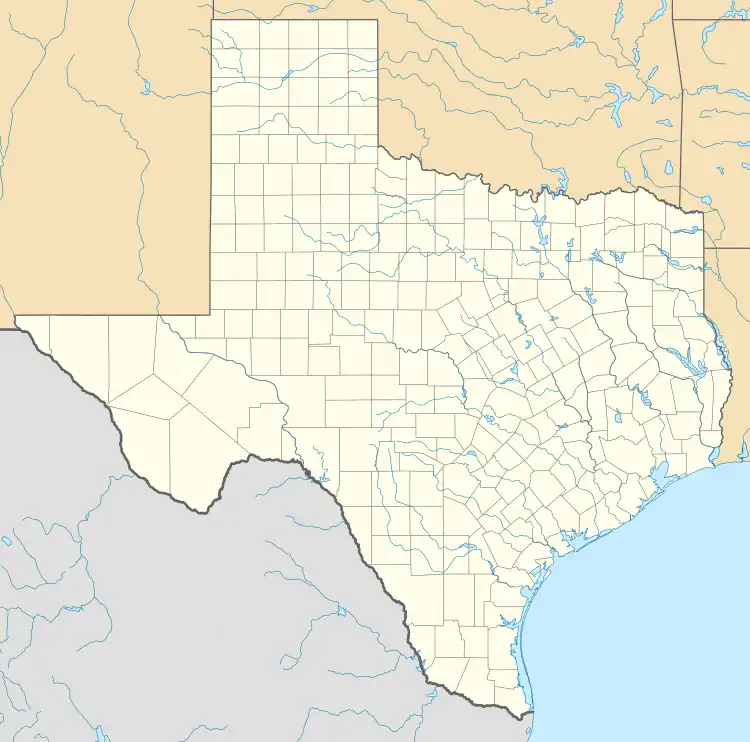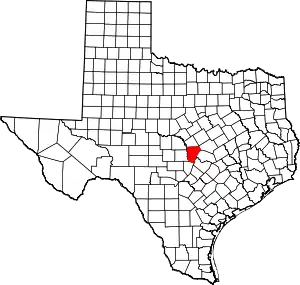Mormon Mill, Burnet County, Texas
Mormon Mill is a vanished Mormon colony established in 1851 on Hamilton Creek in Burnet County, in the U.S. state of Texas. The site is located on Mormon Mills Road 5 miles (8.0 km) north of Marble Falls and 10 miles (16 km) south of Burnet. Mormon Mill has also been known as Mormon Mills, Mormon Mill Colony and Mormon Mill Historical Site. Designated a Recorded Texas Historic Landmark in 1936, Marker number 9733.[3][4] The population moved to another county in 1853, and no buildings remain of the colony.
Mormon Mill, Texas | |
|---|---|
 Mormon Mill, Texas Location within the state of Texas | |
| Coordinates: 30°38′13″N 98°14′02″W | |
| Country | United States |
| State | Texas |
| County | Burnet |
| Elevation | 814 ft (248 m) |
| Time zone | UTC-6 (Central (CST)) |
| • Summer (DST) | UTC-5 (CDT) |
| Area code | 512 |
| FIPS code | 48[1] |
| GNIS feature ID | 1363151[2] |
The settlement
Upon leaving Zodiac in Gillespie County in 1851, Lyman Wight led a group which settled at Hamilton Creek[5] to establish their new colony.[6] As they had at Zodiac, the colonists set up mills for flour, grist, lumber and cotton, along with their furniture factories. One of their achievements was a three-story mill and 26 feet (7.9 m) water wheel by a wooden dam they had erected on the creek. Self-sustaining, while also supplying needed goods and services to nearby communities, the colonists engaged in agriculture, the blacksmith and furniture trades, as well as basketry and clothing manufacturing. Forty-five of the colonists signed the 1851 petition to create Burnet County.[7]
In Burnet County, the Mormons suffered religious persecution, lived in fear of Indian depredations, and found themselves in financial debt. Wight decided to move the group elsewhere, and sold the property to Noah Smithwick. Some of the Mormons remained in Burnet County to work at the mill. Smithwick opened a store and a school for the remaining Mormons, and made mill modifications to encourage use by local farmers.[8] In December 1853 Wight and his followers moved to Bandera County, establishing Mormon Camp in March 1854. While working to establish Mormon Camp, Wight died and was returned to Zodiac for burial. Mormon Camp is now located beneath the man-made Medina Lake in Bandera County.[9]
Decline
Noah Smithwick eventually sold Mormon Mill to his nephew John R. Hubbard. A post office was established on May 23, 1856, with Hubbard as the first postmaster. The post office had four postmasters before being discontinued on April 10, 1860, only to be re-established May 17, 1860, with Joshua H. Eubank as postmaster. The post office was again discontinued January 20, 1869, but re-established June 6, 1870 with Louis Thomas as postmaster. It was then discontinued October 3, 1871, but re-established November 13, 1871, with Louis Winter as postmaster. The post office was discontinued permanently May 6, 1875.[10] The mill had several owners, and the population declined after the post office closed for the last time in 1875. The mill closed permanently in 1901, and most of the structures either later burned down, or the materials recycled elsewhere.
See also
References
- "U.S. Census website". United States Census Bureau. Retrieved 2011-05-14.
- "US Board on Geographic Names". United States Geological Survey. 2007-10-25. Retrieved 2008-01-31.
- "THC Mormon Mill Historical Site". Texas Historical Commission. Retrieved 13 February 2011.
- "Site of Mormon Settlement – Marble Falls, Burnet County, Texas". William Nienke, Sam Morrow. Retrieved 13 February 2011.
- "Hamilton Creek". Handbook of Texas Online. Texas State Historical Association. Retrieved 13 February 2011.
- Morrell, Lea Anne. "Mormon Mill Colony". Handbook of Texas Online. Texas State Historical Association. Retrieved 13 February 2011.
- Bible, Edna Marie (2006). Never Go First. Trafford Publishing. pp. 18, 19. ISBN 978-1-4120-4016-7.
- Henson, Margaret Swett. "Noah Smithwick". Handbook of Texas Online. Texas State Historical Association. Retrieved 13 February 2011.
- Long, Christopher. "Bandera County, Texas". Handbook of Texas Online. Texas State Historical Association. Retrieved 13 February 2011.
- "Burnet County Postmasters". Jim Wheat. Retrieved 13 February 2011.Jim Wheat
